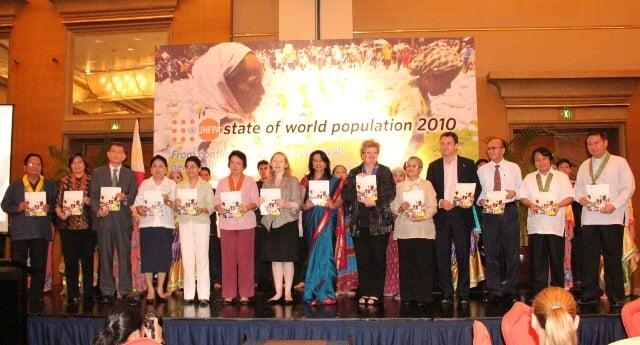“What if I die? Who will take care of my younger siblings?” asked 13-year-old Tima (not her real name) as she narrated between sobs how her family fell apart and she was left responsible for her siblings as a result of the armed conflict in the southern part of the Philippines.
People in the audience were wiping off tears as Tima, the eldest of five siblings, ended her story with a wish for her and her four siblings to be reunited with their parents.
Poverty in their war-torn town in Mindanao drove Tima’s parents to leave them to seek jobs – her mother abroad, and her father in the country’s capital, Manila. Both parents never came back for their children, leaving Tima the responsibility of taking care of her siblings.
Tima told her story at the launch of the State of World Population 2010 report in the Philippines to demonstrate how armed conflict affects the lives of the most vulnerable populations, specifically women and children.
UNFPA Representative Suneeta Mukherjee said that in the Philippines, 40,000 men and women have perished in the armed conflict between government and the Communist Party of the Philippines and about 120,000 more have died as a result of the Moro secessionist movement in Mindanao.
Around 16,205 families or 81,242 individuals remain displaced in Mindanao and are still in evacuation camps. Half of these internally displaced populations are women and girls.
“With their men fighting in the war, women and girls become responsible for the livelihood. They try to make both ends meet by going back to weaving, selling fruits and vegetables which they get from their farms, or operating retail stores within the camps,” Mukherjee said.
The latest State of World Population report takes a look at the 10 years of implementation of the UN Security Council Resolution 1325, which aimed to put to a stop to sexual violence against women and girls in armed conflict and to encourage greater participation by women in peacebuilding initiatives.
UN Resident Coordinator Jacqueline Badcock noted the Philippines’ effort to implement the resolution, being the only country in Asia-Pacific to formulate a National Action Plan on it.
Secretary Teresita Deles, the Presidential Adviser on the Peace Process, affirmed the government commitment to implement the plan, which she described as a comprehensive agenda that covers everything that needs to be done.
“I want to make sure that we can set targets by which we will know that women’s participation in the peace process has really grown. We want to make sure that the continuing discrimination and violence against women in states of armed conflict will really be addressed,” Deles said.
Meanwhile, Social Welfare Undersecretary Celia Capadocia-Yangco said the government is embarking on three main poverty reduction efforts focusing on conflict affected areas, particularly in Mindanao. The efforts include a conditional cash transfer program, infrastructure improvement and sustainable livelihood through skills building.
“These areas for convergence will not only solve the problem of poverty but will eventually reduce the probability of conflict in various areas. Poverty is one of the main causes of conflict; if this issue is addressed, then it lessens the detrimental effect of conflict,” Yangco said.
Officials from other government agencies working on the peace process and human rights, such as the Department of National Defense, Philippines Commission on Women and the office of the Autonomous Region in Muslim Mindanao, were also present at the launch of the report.
* * *
For more information:
Arlene Calaguian Alano: +63 2 901.0306 / alano@unfpa.org


